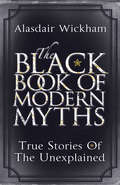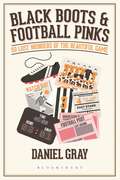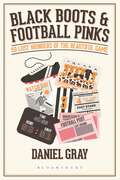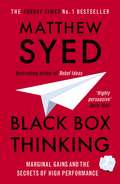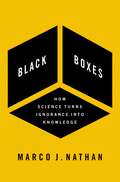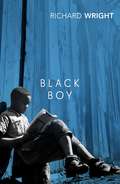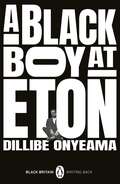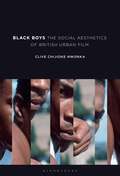- Table View
- List View
The Black Book of Modern Myths: True Stories of the Unexplained
by Alasdair WickhamTHE SUPERNATURAL IS EVERYWHEREIn your home, on the street, in the countryside, around the world:In Denmark, the ghost of the White Lady, who freezes her quarry with an intense chill.In Germany, a succubus, who seduces and devours its prey.In New Zealand, the ghost of a murdered girl, who scrabbles and scratches at a cubicle wall.In Japan, the sea-dwelling Kappa, who drags young children into the icy depths.In Chile, the Chupacabra, a supernatural creature who kills in our world, before leaving for another.In the UK, Satanic cults inhabit the Cornish countryside, awaiting their next unsuspecting victim.No longer can we ignore the signs. Enter the Black Book if you dare to believe.
The Black Book of Outsourcing: How to Manage the Changes, Challenges, and Opportunities
by Douglas Brown Scott WilsonRevised for 2009 and beyond, The Black Book of Outsourcing is a comprehensive guide and directory for the evolving field of outsourcing, including expert advice on how to operate an outsourcing program. Valuable governance checklists, offshoring insights, best practices and one-of-kind resources are featured in this bible of the outsourcing industry. First published in 2005, this topical, bestselling manual explores the evolution of both outsourcing buyers and suppliers. Outsourcing and research gurus Douglas Brown and Scott Wilson chart a course of advice for business leaders charged with managing sourcing initiatives, present a wealth of opportunities for job seekers, and offer insights for entrepreneurial thinkers and investors worldwide
The Black Book of Outsourcing: How to Manage the Changes, Challenges, and Opportunities
by Douglas Brown Scott WilsonRevised for 2009 and beyond, The Black Book of Outsourcing is a comprehensive guide and directory for the evolving field of outsourcing, including expert advice on how to operate an outsourcing program. Valuable governance checklists, offshoring insights, best practices and one-of-kind resources are featured in this bible of the outsourcing industry. First published in 2005, this topical, bestselling manual explores the evolution of both outsourcing buyers and suppliers. Outsourcing and research gurus Douglas Brown and Scott Wilson chart a course of advice for business leaders charged with managing sourcing initiatives, present a wealth of opportunities for job seekers, and offer insights for entrepreneurial thinkers and investors worldwide
The Black Book of Quantum Chromodynamics — A Primer for the LHC Era: A Primer for the LHC Era
by John Campbell Joey Huston Frank KraussThe Black Book of Quantum Chromodynamics is an in-depth introduction to the particle physics of current and future experiments at particle accelerators. The book offers the reader an overview of practically all aspects of the strong interaction necessary to understand and appreciate modern particle phenomenology at the energy frontier. It assumes a working knowledge of quantum field theory at the level of introductory textbooks used for advanced undergraduate or in standard postgraduate lectures. The book expands this knowledge with an intuitive understanding of relevant physical concepts, an introduction to modern techniques, and their application to the phenomenology of the strong interaction at the highest energies. Aimed at graduate students and researchers, it also serves as a comprehensive reference for LHC experimenters and theorists. This book offers an exhaustive presentation of the technologies developed and used by practitioners in the field of fixed-order perturbation theory and an overview of results relevant for the ongoing research programme at the LHC. It includes an in-depth description of various analytic resummation techniques, which form the basis for our understanding of the QCD radiation pattern and how strong production processes manifest themselves in data, and a concise discussion of numerical resummation through parton showers, which form the basis of event generators for the simulation of LHC physics, and their matching and merging with fixed-order matrix elements. It also gives a detailed presentation of the physics behind the parton distribution functions, which are a necessary ingredient for every calculation relevant for physics at hadron colliders such as the LHC, and an introduction to non-perturbative aspects of the strong interaction, including inclusive observables such as total and elastic cross sections, and non-trivial effects such as multiple parton interactions and hadronization. The book concludes with a useful overview contextualising data from previous experiments such as the Tevatron and the Run I of the LHC which have shaped our understanding of QCD at hadron colliders.
Black Book Publishers in the United States: A Historical Dictionary of the Presses, 1817-1990
by Donald Franklin JoyceSince the second decade of the nineteenth century, there have been black-owned book publishers in the United States, addressing the special concerns of black people in ways that other book publishers have not. This is the first work to treat extensively the individual publishing histories of these firms. Though largely ignored by historians, the story of these publishers, as documented in this study, reveals fascinating details of literary history, as well as previously unknown facts about the contribution of blacks to Western civilization.Donald Franklin Joyce offers comprehensive profiles of forty-six publishing companies, selected for inclusion through an examination of major bibliographic works, book advertisements, periodical literature, and business directories. Each profile contains information on the company's publishing history, books and other publications that were released, information sources about the firm, other titles issued, libraries holding titles produced by the publisher, and officers and addresses, where appropriate. Entries are arranged alphabetically by the publisher name, while an appendix presents a geographic listing of the firms and an index offers author, title, and subject access. This work will be an important resource for students, scholars, and researchers interested in cultural and intellectual black history, as well as public and academic libraries seeking specific information on individual publishing companies.
Black Books Galore! Guide to Great African American Children's Books about Boys
by Black Books Galore! Donna Rand Toni Trent ParkerA Treasury of Hundreds of Books that Help Boys Grow and Flourish "Images-strong, proud and happy, brave, and now also humorous . . . what a joy it is to see black faces of all shades in our children's books."-Doug E. Doug, Actor, The Bill Cosby Show "As a child . . . I wish there had been more books that reflected my world and my interests."-Earl G. Graves, Chairman, Publisher, and CEO, Black Enterprise magazine How do you know which books are the best for boys at every age? Now, two of the mothers who founded the esteemed Black Books Galore!-the nation's leading organizer of African American children's book festivals-and the authors of the highly acclaimed Black Books Galore! Guide to Great African American Children's Books, share their expert advice. Let BBG! help you open the door to a wonderful world of reading for the boys in your life. Invaluable for parents, teachers, and librarians, this easy-to-use, delightfully illustrated reference guide features: * Quick, lively descriptions of over 350 books * Hundreds of young black heroes and positive role models * Reflections from kids, famous authors, illustrators, and public figures about their favorite childhood books * Easy-to-find listings organized by age level and indexed by title, topic, author, and illustrator * Recommended reading for parents of boys "This is a great resource that fills a tremendous need. It should be on parents' shelves at home as well as in every school."-Alvin F. Poussaint, M.D., Harvard Medical School, on Black Books Galore! Guide to Great African American Children's Books
Black Boots and Football Pinks: 50 Lost Wonders of the Beautiful Game
by Daniel GrayA delightful exploration of the small details that make football great, from streakers to cup replays, paper tickets to floodlight failings, brawls, fanzines and cycling shorts, and of course, football pinks.Written with wit, nostalgia for the past, and packed with interesting facts to please any football fan.Entries include:1. Sharing the scores from elsewhere2. Referee occupations and hometowns3. Stripy, tartan and other turf patterns4. Black boots5. Late fitness tests6. Streakers7. Knowing the names of grounds8. Keepers in trousers and hats9. Local shirt and hoarding sponsors10. Football Pinks
Black Boots and Football Pinks: 50 Lost Wonders of the Beautiful Game
by Mr Daniel GrayA delightful exploration of the small details that make football great, from streakers to cup replays, paper tickets to floodlight failings, brawls, fanzines and cycling shorts, and of course, football pinks.Written with wit, nostalgia for the past, and packed with interesting facts to please any football fan.Entries include:1. Sharing the scores from elsewhere2. Referee occupations and hometowns3. Stripy, tartan and other turf patterns4. Black boots5. Late fitness tests6. Streakers7. Knowing the names of grounds8. Keepers in trousers and hats9. Local shirt and hoarding sponsors10. Football Pinks
The Black Box: Writing the Race
by Henry Louis Gates JrA foundational reckoning with how Black Americans have used the written word to define and redefine themselves over the course of the country's history.Distilled over many years from Henry Louis Gates Jr's legendary Harvard course in African American Studies, The Black Box: Writing the Race is the story of Black self-definition in America through the prism of the writers who have led the way. From Phillis Wheatley and Frederick Douglass, W. E. B. Du Bois and Booker T. Washington, to Zora Neale Hurston and Richard Wright, James Baldwin and Toni Morrison, these writers used words to create a liveable world – a “home” – for Black people destined to live in a bitterly racist society.This is a community that defined and transformed itself in defiance of oppression and lies; a collective act of resistance and transcendence that is at the heart of its self-definition. Out of that contested ground has flowered a resilient, creative, powerful, diverse culture formed by people who have often disagreed markedly about what it means to be 'Black', and about how best to shape a usable past out of the materials at hand, to call into being a more just and equitable future.This is the epic story of how, through essays and speeches, novels, plays and poems, a long line of creative thinkers has unveiled the contours of – and resisted confinement in – the black box that this “nation within a nation” has been assigned, from its founding to today. It is a book that records the compelling saga of the creation of a people.
Black-Box Beratung?: Empirische Studien zu Coaching und Supervision (Coaching und Supervision)
by Karolina Galdynski Stefan KühlWas findet in Coaching- und Supervisionssitzungen statt? Was sind die gewollten und ungewollten Erklärungsmuster, die sich in Beratungsgesprächen durchsetzen? Welche Rolle spielt die nur begrenzt gelungene Professionsbildung? In diesem Sammelband erkunden die Autoren in einer Reihe empirischer Studien, wie sich die Popularität von Coaching und Supervision erklären lässt, welche Strategien der Professionsbildung verfolgt werden, welche Funktionen die personenorientierte Beratung erfüllt und wie Erfolge und Misserfolge von Beratungen evaluiert werden. Zur Untersuchung werden von den Autoren verschiedene quantitative und qualitative Methoden der empirischen Sozialforschung, z.B. Experteninterviews, Interaktionsanalysen, Dokumentenanalyse und Printmedienanalyse eingesetzt und so ein vielfältiges Bild von Coaching und Supervision gezeichnet.
Black Box Casino: How Wall Street's Risky Shadow Banking Crashed Global Finance
by Robert Stowe EnglandThis cautionary tale explains how the murky and complex world of mortgage finance caused a global market meltdown—and offers new insights on how to create a stronger world of banking and mortgage finance.Years after the economic crisis of the late 2000s, Americans still want to know what went wrong—and why. Black Box Casino: How Wall Street's Risky Shadow Banking Crashed Global Finance provides an accurate and understandable explanation, compiling and interpreting mountains of evidence to provide clear analysis and insight into the crisis that traumatized people and institutions around the globe.The book provides a thorough, in-depth examination of the multiple contributing factors. The author goes back as far as 15 years before the crisis to show how the well-intentioned idea of providing home ownership prompted a government led effort to steadily weaken credit standards. He assigns partial blame on regulators that were unaware of growing levels of risk, ignored mounting evidence of a housing bubble, and failed to grasp the unintended consequences of certain regulations. The origins of the overload of subprime collateralized debt obligations that led to concentrated risks on the balance sheets of many large banks around the world are also explained.
Black-Box Models of Computation in Cryptology
by Tibor JagerGeneric group algorithms solve computational problems defined over algebraic groups without exploiting properties of a particular representation of group elements. This is modeled by treating the group as a black-box. The fact that a computational problem cannot be solved by a reasonably restricted class of algorithms may be seen as support towards the conjecture that the problem is also hard in the classical Turing machine model. Moreover, a lower complexity bound for certain algorithms is a helpful insight for the search for cryptanalytic algorithms. Tibor Jager addresses several fundamental questions concerning algebraic black-box models of computation: Are the generic group model and its variants a reasonable abstraction? What are the limitations of these models? Can we relax these models to bring them closer to the reality?
The Black Box of Biology: A History of the Molecular Revolution
by Michel MorangeIn this masterful account, a historian of science surveys the molecular biology revolution, its origin and continuing impact. Since the 1930s, a molecular vision has been transforming biology. Michel Morange provides an incisive and overarching history of this transformation, from the early attempts to explain organisms by the structure of their chemical components, to the birth and consolidation of genetics, to the latest technologies and discoveries enabled by the new science of life. Morange revisits A History of Molecular Biology and offers new insights from the past twenty years into his analysis. The Black Box of Biology shows that what led to the incredible transformation of biology was not a simple accumulation of new results, but the molecularization of a large part of biology. In fact, Morange argues, the greatest biological achievements of the past few decades should still be understood within the molecular paradigm. What has happened is not the displacement of molecular biology by other techniques and avenues of research, but rather the fusion of molecular principles and concepts with those of other disciplines, including genetics, physics, structural chemistry, and computational biology. This has produced decisive changes, including the discoveries of regulatory RNAs, the development of massive scientific programs such as human genome sequencing, and the emergence of synthetic biology, systems biology, and epigenetics. Original, persuasive, and breathtaking in its scope, The Black Box of Biology sets a new standard for the history of the ongoing molecular revolution.
The Black Box of Governance: Boards of Directors Revealed by Those Who Inhabit Them
by Sandra GuerraIn the world of corporate governance, the board of directors is often viewed as the "black box" of companies: only the board members who are seated at the meeting table understand how this "decision-making machine" works. In this book, a board member with over 25 years’ experience pulls off the lid and shows both how boards have worked and how they could work. This book is grounded in extensive research in three different surveys: one with more than 100 Brazilian directors, another with 340 board members from 40 countries, and a final one with 103 Brazilian directors serving on 238 boards. It also includes interviews with Ira Millstein, Sir Adrian Cadbury, Robert Monks and Mervyn King. The inner-workings of the board of directors are revealed: • What keeps directors awake at night • Obstacles to efficient decision-making • Behavioral dynamics, both within the board and in relation to the management • Pitfalls that arise from individual and group biases Based on these insights and the author’s own consulting and board experience, the book presents a guide to behavioral tools enabling directors and executives to confidently navigate the boardroom, improving interactivity and the efficiency of the decision-making process. Intended for directors and executives who are directly involved in the board's activities, as well as for leaders responsible for strategy implementation, this book provides a behavioral compass for all those interacting with the "black box."
The Black Box of Governance: Boards of Directors Revealed by Those Who Inhabit Them
by Sandra GuerraIn the world of corporate governance, the board of directors is often viewed as the "black box" of companies: only the board members who are seated at the meeting table understand how this "decision-making machine" works. In this book, a board member with over 25 years’ experience pulls off the lid and shows both how boards have worked and how they could work. This book is grounded in extensive research in three different surveys: one with more than 100 Brazilian directors, another with 340 board members from 40 countries, and a final one with 103 Brazilian directors serving on 238 boards. It also includes interviews with Ira Millstein, Sir Adrian Cadbury, Robert Monks and Mervyn King. The inner-workings of the board of directors are revealed: • What keeps directors awake at night • Obstacles to efficient decision-making • Behavioral dynamics, both within the board and in relation to the management • Pitfalls that arise from individual and group biases Based on these insights and the author’s own consulting and board experience, the book presents a guide to behavioral tools enabling directors and executives to confidently navigate the boardroom, improving interactivity and the efficiency of the decision-making process. Intended for directors and executives who are directly involved in the board's activities, as well as for leaders responsible for strategy implementation, this book provides a behavioral compass for all those interacting with the "black box."
Black Box Optimization, Machine Learning, and No-Free Lunch Theorems (Springer Optimization and Its Applications #170)
by Panos M. Pardalos Varvara Rasskazova Michael N. VrahatisThis edited volume illustrates the connections between machine learning techniques, black box optimization, and no-free lunch theorems. Each of the thirteen contributions focuses on the commonality and interdisciplinary concepts as well as the fundamentals needed to fully comprehend the impact of individual applications and problems. Current theoretical, algorithmic, and practical methods used are provided to stimulate a new effort towards innovative and efficient solutions. The book is intended for beginners who wish to achieve a broad overview of optimization methods and also for more experienced researchers as well as researchers in mathematics, optimization, operations research, quantitative logistics, data analysis, and statistics, who will benefit from access to a quick reference to key topics and methods. The coverage ranges from mathematically rigorous methods to heuristic and evolutionary approaches in an attempt to equip the reader with different viewpoints of the same problem.
The Black Box Society: The Secret Algorithms That Control Money and Information
by Frank PasqualeEvery day, corporations are connecting the dots about our personal behavior—silently scrutinizing clues left behind by our work habits and Internet use. But who connects the dots about what firms are doing with all this information? Frank Pasquale exposes how powerful interests abuse secrecy for profit and explains ways to rein them in.
The Black Box Society: The Secret Algorithms That Control Money and Information
by Frank PasqualeEvery day, corporations are connecting the dots about our personal behavior—silently scrutinizing clues left behind by our work habits and Internet use. But who connects the dots about what firms are doing with all this information? Frank Pasquale exposes how powerful interests abuse secrecy for profit and explains ways to rein them in.
Black Box Thinking: The Surprising Truth About Success
by Matthew SyedThe Sunday Times No.1 Bestseller From the Bestselling Author of BounceWhat links the Mercedes Formula One team with Google?What links Team Sky and the aviation industry?What connects James Dyson and David Beckham?They are all Black Box Thinkers.Black Box Thinking is a new approach to high performance, a means of finding an edge in a complex and fast-changing world. It is not just about sport, but has powerful implications for business and politics, as well as for parents and students. In other words, all of us.Drawing on a dizzying array of case studies and real-world examples, together with cutting-edge research on marginal gains, creativity and grit, Matthew Syed tells the inside story of how success really happens - and how we cannot grow unless we are prepared to learn from our mistakes.
The Black Boxer Tales
by H. E. BatesThe Black Boxer Tales, first published in 1932, H. E. Bates's third collection displays a growing emphasis on plot and characterisation, while amply displaying his established skill at creating plotless atmospheric pieces. Several stories explore a sense of a new and changing world of carnivals, economic challenges and traveling performers.The title story, 'The Black Boxer' is an intricate portrait of an aging boxer told against the backdrop of the colourful social lives of carnival workers. Having beaten a fighter twenty years his junior with a foul cut below the belt, he is left 'tired and stupefied and ashamed' in Bates's sensitive exploration of the human condition. Bates condsidered this tale, along with 'Charlotte Esmond', also in this collection, as accomplishing his difficult transition from a focus on mood to a focus on character, thereby projecting him 'into a new world' which he is clearly relishing and mastering. The rest of the collection is a thoughtful contrast portraying the landscape and people familiar from his previous Midlands tales, with themes of children and youth in 'A Flower Piece' and 'Death in Spring', farmland settings in 'The Mower' and 'Sheep', and looking at innocent and not-so-innocent flirtations in 'A Threshing Day for Esther' and 'Love Story' respectively.Additionally, as a bonus story never before featured in any collection, 'The Laugh' (1926) is one of Bates's early comic tales set in his trademark rural locale with charming dialect and witty, sensitive prose. The story follows a young man, the pending visit of his rich aunt, and a sweetheart who tests his love. The Spectator calls him 'a sensitive observer, with a quick eye for significant gesture, a tender imagination, and a sure way with words,' while the Times Literary Supplement comments on his 'mastery of both matter and manner.'
Black Boxes: How Science Turns Ignorance Into Knowledge
by Marco J. NathanTextbooks and other popular venues commonly present science as a progressive "brick-by-brick" accumulation of knowledge and facts. Despite its hallowed history and familiar ring, this depiction is nowadays rejected by most specialists. There currently are two competing models of the scientific enterprise: reductionism and antireductionism. Neither provides an accurate depiction of the productive interaction between knowledge and ignorance, supplanting the old metaphor of the "wall" of knowledge. This book explores an original conception of the nature and advancement of science. Marco J. Nathan's proposed shift brings attention to a prominent, albeit often neglected, construct--the black box--which underlies a well-oiled technique for incorporating a productive role of ignorance and failure into the acquisition of empirical knowledge. The black box is a metaphorical term used by scientists for the isolation of a complex phenomenon that they have deliberately set aside or may not yet fully understand. What is a black box? How does it work? How do we construct one? How do we determine what to include and what to leave out? What role do boxes play in contemporary scientific practice? Nathan's monograph develops an overarching framework for thinking about black boxes and discusses prominent historical cases that used it, including Darwin's view of inheritance in his theory of evolution and the "stimulus-response model" in psychology, among others. By detailing some fascinating episodes in the history of biology, psychology, and economics, Nathan revisits foundational questions about causation, explanation, emergence, and progress, showing how the insights of both reductionism and antireductionism can be reconciled into a fresh and exciting approach to science.
Black Boxes: How Science Turns Ignorance Into Knowledge
by Marco J. NathanTextbooks and other popular venues commonly present science as a progressive "brick-by-brick" accumulation of knowledge and facts. Despite its hallowed history and familiar ring, this depiction is nowadays rejected by most specialists. There currently are two competing models of the scientific enterprise: reductionism and antireductionism. Neither provides an accurate depiction of the productive interaction between knowledge and ignorance, supplanting the old metaphor of the "wall" of knowledge. This book explores an original conception of the nature and advancement of science. Marco J. Nathan's proposed shift brings attention to a prominent, albeit often neglected, construct--the black box--which underlies a well-oiled technique for incorporating a productive role of ignorance and failure into the acquisition of empirical knowledge. The black box is a metaphorical term used by scientists for the isolation of a complex phenomenon that they have deliberately set aside or may not yet fully understand. What is a black box? How does it work? How do we construct one? How do we determine what to include and what to leave out? What role do boxes play in contemporary scientific practice? Nathan's monograph develops an overarching framework for thinking about black boxes and discusses prominent historical cases that used it, including Darwin's view of inheritance in his theory of evolution and the "stimulus-response model" in psychology, among others. By detailing some fascinating episodes in the history of biology, psychology, and economics, Nathan revisits foundational questions about causation, explanation, emergence, and progress, showing how the insights of both reductionism and antireductionism can be reconciled into a fresh and exciting approach to science.
Black Boy (P. S. Series)
by Richard Wright'In Black Boy I found expressed, for the first time in my life, the sorrow, the rage, and the murderous bitterness which was eating up my life and lives of those around me. [Richard Wright's] work was an immense liberation and revelation for me. He became my ally and my witness, and alas! my father' - James BaldwinAt four years of age, Richard Wright set fire to his home; at five his father deserted the family; by six Richard was - temporarily - an alcoholic. Moved from home to home, from brick tenement to orphanage, he had had, by the age of twelve, only one year's formal education. It was in saloons, railroad yards and streets that he learned the facts about life under white subjection, about fear, hunger and hatred. Gradually he learned to play Jim Crow in order to survive in a world of white hostility, secretly satisfying his craving for books and knowledge until the time came when he could follow his dream of justice and opportunity in the north.
A Black Boy at Eton (Black Britain: Writing Back)
by Dillibe Onyeama'The story [Onyeama] had to tell was so gripping and shocking, it wouldn't let me go . . . A remarkably well-written memoir' Bernardine Evaristo, from the IntroductionDillibe was the second black boy to study at Eton - joining in 1965 - and the first to complete his education there. Written at just 21, this is a deeply personal, revelatory account of the racism he endured during his time as a student at the prestigious institution. He tells in vivid detail of his own background as the son of a Nigerian judge at the International Court of Justice at The Hague, of his arrival at the school, of the curriculum, of his reception by other boys (and masters), and of his punishments. He tells, too, of the cruel racial prejudice and his reactions to it, and of the alienation and stereotyping he faced at such a young age. A Black Boy at Eton is a searing, ground-breaking book displaying the deep psychological effects of colonialism and racism.A title in the Black Britain: Writing Back series - selected by Booker Prize-winning author Bernardine Evaristo, this series rediscovers and celebrates pioneering books depicting black Britain that remap the nation.
Black Boys: The Social Aesthetics of British Urban Film
by Clive Chijioke NwonkaIn Black Boys: The Aesthetics of British Urban Film, Nwonka offers the first dedicated analysis of Black British urban cinematic and televisual representation as a textual encounter with Blackness, masculinity and urban identity where the generic construction of images and narratives of Black urbanity is informed by the (un)knowable allure of Black urban Otherness. Foregrounding the textual Black urban identity as a historical formation, and drawing on a range of theoretical frameworks that allow for an examination of the emergence and continued social, cultural and industrial investment in the fictitious and non-fictitious images of Black urban identities and geographies, Nwonka convenes a dialogue between the disciplines of Film and Television Studies, Philosophy, Cultural Studies, Black Studies, Sociology and Criminology. Here, Nwonka ventures beyond what can be understood as the perennial and simplistic optic of racial stereotype in order to advance a more expansive reading of the Black British urban text as the outcome of a complex conjunctural interaction between social phenomena, cultural policy, political discourse and the continuously shifting politics of Black representation. Through the analysis of a number of texts and political and socio-cultural moments, Nwonka identifies Black urban textuality as conditioned by a bidirectionality rooted in historical and contemporary questions of race, racism and anti-Blackness but equally attentive to the social dynamics that render the screen as a site of Black recognition, authorship and authenticity. Analysed in the context of realism, social and political allegory, urban multiculture, Black corporeality and racial, gender and sexual politics, in integrating such considerations into the fabrics of a thematic reading of the Black urban text and through the writings of Stuart Hall, Paul Gilroy, Judith Butler and Derrida, Black Boys presents a critical rethinking of the contextual and aesthetic factors in the visual constructions of Black urban identity.
